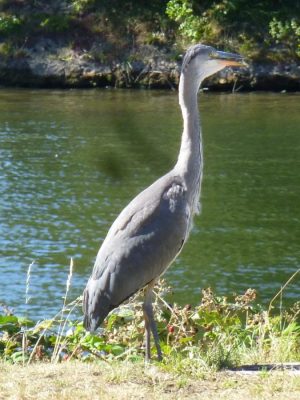This statuesque figure (see picture below) visited the good folk of Ditton Reach the other day. The grey heron, which was strutting its stuff along the riverbank in Long Ditton, was snapped by Good Life deliverer Irene Reece. “The heron lives in Home Park but we have no idea if they have nested as
This statuesque figure (see picture below) visited the good folk of Ditton Reach the other day.
The grey heron, which was strutting its stuff along the riverbank in Long Ditton, was snapped by Good Life deliverer Irene Reece.
“The heron lives in Home Park but we have no idea if they have nested as we have only seen him alone always,” explained Irene. “The seagulls have huge respect for him!
“We only get the occasional sighting at Ditton Reach slipway where he comes to fish.”

The Good Life’s bird expert Liz Hunter, said: “An adult would have a white forehead, stronger wing markings plus a plume of black feathers on the back of its head. On balance I would think it is a juvenile – by this stage there would not really be a size difference.
“There is not really a plumage difference between male and female – although I’m sure they can tell!”
Grey herons can be seen around any kind of water – garden ponds, rivers, lakes and estuaries.
They are tall, around 3ft 4in (100cm) and have a wingspan of 6ft 5in (195cm) – see main picture. They have long legs, a long beak, and grey, black and white feathers. They eat a lot of fish, but are also partial to amphibians, small birds like ducklings and small mammals such as voles.
They can be seen all year round in the UK and do not migrate.









Leave a Comment
Your email address will not be published. Required fields are marked with *